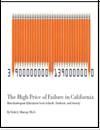Remedial education classes for students enrolling in the state’s public colleges and universities are costing California as much as $14 billion a year, according to a report from the Pacific Research Institute.

That figure was reached after the authors estimated several costs, including the $274 million the colleges spend providing remedial instruction.
Institute researchers also factored in other costs it associated with inadequate preparation for college, including the $107 million to $447 million spent on job-training once a student finds employment.
Local college officials said the report confirms that students need a stronger foundation in math and English.
Over the past two years, Pasadena City College has increased its offerings of “basic skills” math and English courses, said Juan Gutierrez, PCC spokesman.
Incoming freshmen take assessment tests, which determine whether they need remedial classes and in what areas, he said.
In the 2006-07 school year, the college offered 251 basic skills classes. This past school year, 256 basic skills classes were offered.
The increase in remedial classes means more faculty have to be hired for the 30,000- student college, Gutierrez said.
“When we see there is a need, we start shifting resources to fill it. It is part of our mission, in that we are an open college, so we provide the basic skills courses,” he said.
Preparing students for college-level classes extends beyond students passing remedial courses. Many colleges have to offer tutoring and peer-mentoring services and other resources to students, local college officials say.
The two-year colleges get money for remedial classes through the Basic Skills Initiative.
In the 2007-08 school year, the colleges shared $33 million from the Basic Skills Initiative. For this coming school year, the colleges have requested $85 million, based on the growing need for remedial classes.
In the proposed 2008-09 state budget, however, the initiative is slated to receive just over $29 million.
Paul Parnell, vice president for academic affairs at Rio Hondo Community College, said the number of pre-collegiate and basic skills courses the college offers has decreased slightly, down to 176 math and English courses during the 2006-07 school year. During the 2004-05 school year, it offered 183 such courses.
Parnell said college officials meet regularly with their K-12 school counterparts to discuss ways to better prepare students.
Parnell said that the state’s high school dropout rate of 24 percent shows that K-12 schools have many challenges to overcome.
“These students need to go somewhere, and they usually come to us,” he said.
Among the Pacific Research Institute’s recommendations is that the state begin testing students earlier – before the 11th grade – to measure whether they are on track for college.
Remedial education a big cost for state’s colleges
Caroline An
Remedial education classes for students enrolling in the state’s public colleges and universities are costing California as much as $14 billion a year, according to a report from the Pacific Research Institute.
That figure was reached after the authors estimated several costs, including the $274 million the colleges spend providing remedial instruction.
Institute researchers also factored in other costs it associated with inadequate preparation for college, including the $107 million to $447 million spent on job-training once a student finds employment.
Local college officials said the report confirms that students need a stronger foundation in math and English.
Over the past two years, Pasadena City College has increased its offerings of “basic skills” math and English courses, said Juan Gutierrez, PCC spokesman.
Incoming freshmen take assessment tests, which determine whether they need remedial classes and in what areas, he said.
In the 2006-07 school year, the college offered 251 basic skills classes. This past school year, 256 basic skills classes were offered.
The increase in remedial classes means more faculty have to be hired for the 30,000- student college, Gutierrez said.
“When we see there is a need, we start shifting resources to fill it. It is part of our mission, in that we are an open college, so we provide the basic skills courses,” he said.
Preparing students for college-level classes extends beyond students passing remedial courses. Many colleges have to offer tutoring and peer-mentoring services and other resources to students, local college officials say.
The two-year colleges get money for remedial classes through the Basic Skills Initiative.
In the 2007-08 school year, the colleges shared $33 million from the Basic Skills Initiative. For this coming school year, the colleges have requested $85 million, based on the growing need for remedial classes.
In the proposed 2008-09 state budget, however, the initiative is slated to receive just over $29 million.
Paul Parnell, vice president for academic affairs at Rio Hondo Community College, said the number of pre-collegiate and basic skills courses the college offers has decreased slightly, down to 176 math and English courses during the 2006-07 school year. During the 2004-05 school year, it offered 183 such courses.
Parnell said college officials meet regularly with their K-12 school counterparts to discuss ways to better prepare students.
Parnell said that the state’s high school dropout rate of 24 percent shows that K-12 schools have many challenges to overcome.
“These students need to go somewhere, and they usually come to us,” he said.
Among the Pacific Research Institute’s recommendations is that the state begin testing students earlier – before the 11th grade – to measure whether they are on track for college.
Nothing contained in this blog is to be construed as necessarily reflecting the views of the Pacific Research Institute or as an attempt to thwart or aid the passage of any legislation.